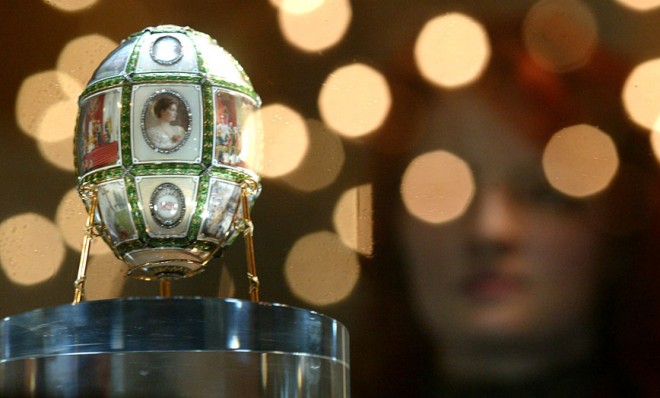5 supposedly priceless items that we've all over-hyped
Let's face it: Priceless items are priceless because we all agree that they are, not because they have some immense intrinsic value.


It's not surprising that a handwritten Mozart concerto is immensely valuable. After all, there's only one, the document was in intimate contact with its famous creator, and it has survived centuries, despite being written on something as insubstantial as paper. It even has intrinsic value; you can slap it on your piano scroll and play it!
But what about the more useless, sturdy, and plentiful supposedly priceless objects that the world adores? Where does their worth come from?
There are usually similar factors involved in valuation: age, rarity, preservation, beauty. But why is the Mona Lisa more important than the perfectly lovely portrait of Isabella of Portugal? Why do we all know what a Stradivarius is, but have never heard of its contemporary, the Amati? Short answer: Priceless items are priceless because we all agree that they are. Here, a look at the some of the most famous "priceless" objects in the world, and how they got that way.
The Week
Escape your echo chamber. Get the facts behind the news, plus analysis from multiple perspectives.

Sign up for The Week's Free Newsletters
From our morning news briefing to a weekly Good News Newsletter, get the best of The Week delivered directly to your inbox.
From our morning news briefing to a weekly Good News Newsletter, get the best of The Week delivered directly to your inbox.
1. Faberge eggs
The opulent, jewel-encrusted Russian Easter eggs are actually only a tiny sliver of the goods that the jewelers at The House of Faberge made in the late 19th and early 20th centuries. The famous eggs were actually "Imperial Eggs," made under the direct supervision of Peter Carl Fabergé himself, and presented only to the Imperial Family of Russia. Only about 50 were ever made.
The eggs have all the components of luxury: intricate and unique artwork, dripping in jewels, and rarity. There is an extra ingredient to these eggs, however, to make them irresistible: Tragedy. Communists overthrew the Royal Family, murdering the Tsar, Tsarina and their little children (the fabled Anastasia) in a basement. Peter Carl Faberge fled Russia and never recovered. The House of Faberge continued to exist, but the name was sold over and over and soon had no relation to the famous artisan.
2. Stradivarius violins
A free daily email with the biggest news stories of the day – and the best features from TheWeek.com
About 650 of the stringed instruments (harps, guitars, violins) that Antonio Stradivari made in the late 17th and early 18th centuries still exist today. (There are many, many more violins that have the Stradivarius name on them, but they are usually cheap 19th century replicas made to honor the style of the master). Most are violins, and they are generally considered to be the finest instruments in the world. They sell for millions and are cherished by master violinists everywhere.
But why? Stradivari did implement a lot of new ideas with his violins. He redesigned the sound boxes, the f-holes, the geometry of the wood, and even chose a rich red varnish that would best complement the vibration of the instrument. Plus he was an artist. Strads are beautiful. Many people believe these details came together in a symphony of perfection, creating an instrument whose sound quality is unrivaled.
Unfortunately, time and time again, actual double blind tests prove this is untrue. One test for the Strad is to have professional violinists put on dark goggles and play the famous instrument along with more common ones. Even though they hold the Strad in their hands and hear its famous reverberations right next to their ears, they can't tell it apart from a well-made 1970s violin. It seems the perfection and value of the Stradivarius is in the heart, not the head.
3. Mona Lisa
As soon as Leonardo da Vinci was done painting Mona Lisa in the 16th century, he carried it with him all over Europe to show potential patrons what he was capable of doing. And by the standards of the day, he was extremely capable. We don't notice it now, because of commonplace photorealism, but Lisa looks real, and intimately so. It was a game-changing presentation.
And then there's the delicious little mystery: No one knows for certain who she is. Most art historians believe she is Lisa del Giocondo, the wife of Florentine silk merchant. But da Vinci never said for certain. Mona Lisa is famous for her smile, because it's conveying an emotion, but everyone gets to decide for themselves what that emotion is. Come hither? Wise to your bull? Content? Weary?
She got another huge boost in popularity when she was stolen in 1911. That was also when imitations and mockeries of Mona Lisa began (who can't picture her as clearly with a drawn-on mustache as without?) as people lampooned the police for not making more headway in the investigation.
But Mona Lisa is famous (and priceless) because of the law of inertia. Fame in motion with nothing to stop it tends to stay in motion, growing bigger and more expensive with each pop culture reference and parody.
4. Ming vases
First of all, they're vases. That means that every pratfall comedian in history has been hunting them down, trying to bump their bottoms into the rickety tables the vases are perched on, all in the hope that a fat man will be so shocked his monocle will fall in his champagne glass.
The Chinese made beautiful vases for millennia, not just during the 1368–1644 Ming Dynasty, though ceramic techniques did improve vastly during these years. Craftsman learned to make sharper images, more dramatic shaping, and different textures. But that is not unique to China or to the Ming years. The real reason "Ming" jumps to our minds is because it was during the Ming Dynasty that China started exporting their ceramics to Europe. All the hoity-toity folks in Europe wanted a beautiful souvenir of this exotic land, and the ceramics they bought happened to be Ming. Also, Europeans can pronounce "Ming," allowing it to stick in the head. Not so much "Qianlong," and other brilliant eras of ceramic artistry.
5. Diamonds
Be honest. In a blind test, could you tell a diamond from a cubic zirconium? From cut crystal? Cut glass? Of course there are differences. A well-cut diamond may throw sparkles and rainbows that no other gem could counter. But how is it that those sparkling little rocks have become the most valuable thing on earth?
True, they have some industrial uses because of their hardness and conductivity. But African villages were not enslaved or slaughtered in the pursuit of sharper saw-teeth. The main reason you think diamonds are valuable, according to expert Ira Weissman and renowned journalist Edward Jay Epstein, is that De Beers has been working very hard for almost a century to convince you that they are.
Diamonds are rare — but not as rare as they were before the 1870s, when huge diamond mines were discovered in South Africa. That increase of supply created a terrible conundrum for the people who owned the mines. Rarity was how they justified the expense of these pretty little rocks. So they joined together, and formed De Beers (named after one of the diamond fields) Consolidated Mines Ltd, and soon controlled all the diamond traffic in South Africa. By 1920, De Beers controlled 90 percent of the world's production and distribution of diamonds. But sales began to dwindle. So, in the 1930s, De Beers began a psychological campaign that so successfully infected the populace that it remains largely unchallenged today: "A diamond is forever."
True commitment requires traditional diamonds. Diamonds are rare, and special, like the woman you love. Except how can they be? A friend of mine, Newmont Mining Exploration Geologist Ajeet Milliard, summed up the contradiction of the "rarity" of diamonds this way: "'They' say diamonds are special, yet everyone has one on their wedding band."
So perhaps it is true that a diamond is the most valuable jewel; the highest symbol of wealth, luxury and even devotion, in the entire world. But if it is true, like all priceless objects, it's only because we want it to be.
Therese O'Neill lives in Oregon and writes for The Atlantic, Mental Floss, Jezebel, and more. She is the author of New York Times bestseller Unmentionable: The Victorian Ladies Guide to Sex, Marriage and Manners. Meet her at writerthereseoneill.com.
-
 A luxury walking tour in Western Australia
A luxury walking tour in Western AustraliaThe Week Recommends Walk through an ‘ancient forest’ and listen to the ‘gentle hushing’ of the upper canopy
-
 What Nick Fuentes and the Groypers want
What Nick Fuentes and the Groypers wantThe Explainer White supremacism has a new face in the US: a clean-cut 27-year-old with a vast social media following
-
 5 highly amusing cartoons about rising health insurance premiums
5 highly amusing cartoons about rising health insurance premiumsCartoon Artists take on the ACA, Christmas road hazards, and more
